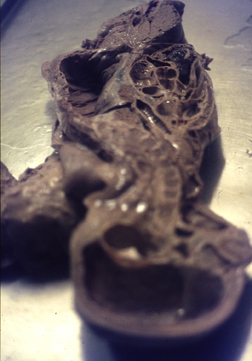<S.P.K.>
Dokument III
Text by K. Osmosis
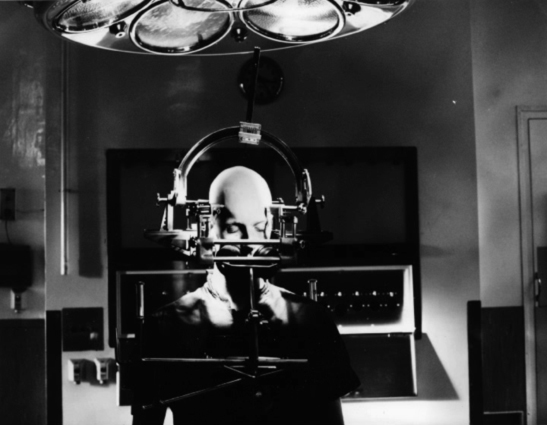
This <SPK> document is part of an evolving
project inspired by the collective vision of the group, and expressed
in the prose and poetry of K. Osmosis. These ruminations are dispersed
across the property: <SPK> DESPAIR 2007, which
includes the DVD "Despair", and the textual material contained on
the website linked to this DVD, viewable at: http://www.vogania.com/MUSIC/SPK.html. These
writings are the property of SPK and K. Osmosis, and may only be reproduced
with the author's consent.
Introduction
The following discourse may be considered as a rhizomatic work in
flux. I hereby embark on a schizolytic concatenation of ideas.

The
Schreber Experience
Interestingly, Sigmund Freud's exploration of schizophrenia in his
exhaustive case study of the convoluted paranoid delusions of his
famous patient - a prominent lawyer who suffered a schizophrenic breakdown
- Dr Daniel Paul Schreber, provides a fascinating description and
incisive insight into the mechanisms of psychosis and its interdependence
with the traditional patriarchal, nuclear family and the life-denying
ethos of bourgeois society.
From the age of three, Schreber was bathed by his mother in ice-water
in accordance with his father's instructions. Schreber's father -
a doctor and pedagogue - devised a series of elaborately engineered
orthopaedic 'toys', or rather, constraints for his son, including
an ornate 'shoulder-band', a figure-eight of metal and leather whose
two loops, tightly curving around and strapped to the middle of his
back, in combination with a 'straight-hold'- an iron cross-bar fastened
to a table - compressed the boy's collarbones and shoulders. These
mechanical devices were designed specifically to prevent any 'unproductive'
movements or 'wasteful' spontaneity; it also ensured the young Schreber's
rigid adherence to the 'dignified', 'upright' posture commensurate
with his social position as an upstanding and 'respectable' member
of the bourgeoisie.
Needless to say, the micro-despotism of Dr Schreber's nuclear familial
structure in conjunction with the macro-despotism of capitalist society,
resulted in the efflorescence of Schreber's unique brand of schizophrenia,
a psychotic breakdown brilliantly transcribed in the schizophrenic
language of his diary accounts. The 'miraculous machines' contrived
to discipline Schreber's body, articulate themselves into a paranoid
system where the brain is conceived as a network of canals and relays,
and personality disintegrates into a series of information transfers
and biochemical processes. Schreber struggles against a host of imaginary
persecutors intent on the systematic, 'scientific' murder of his soul
as he undergoes a process of becoming-woman.
Schreber's
seminal role in Deleuzian ideas and the praxis of <SPK>

The schizophrenic discourse employed by Schreber in his diary to
express the experiences of his mental disintegration provides the
vocabulary for Anti-Oedipus: Capitalism and Schizophrenia,
a
seminal 'schizo-text' co-written by the philosopher Gilles Deleuze
and the psychoanalyst Felix Guattari, whose ideas resemble the praxis
of <SPK>, reproducing the delirium they analyze such that the
traditional distinctions between 'form' and 'content' breakdown through
a frenzied collage of theoretical flights of fancy in conjunction
with images designed to shock and disturb the viewer. The objective
is to engender 'shizo-subjects' engaged in 'lines of flight' involving
liberation from repressive social codes and rigid psychic boundaries,
where cracks appear in the faŤade of 'identity' and the subject is
shattered in the process of becoming-multiple.
<SPK>, Deleuze and Guattari share a common fascination with
the body "in terms of flesh and meat" and the mutual relationship
between the bones "as the material structure of the body" and the
flesh "as the corporeal material".
<SPK>'s Rhizomatic Dialectical Coporalia
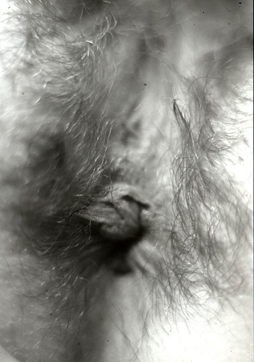
<SPK>'s representation of grotesque imagery corresponds with
its exploration of the socially marginalised or 'abject' - with gross
deformity, filth, and disease. An attempt to look beneath the skin,
to penetrate into the very visceral structure of what constitutes
human identity and the human condition (our intestines, tubes, veins,
etc.).
Ancient creation myths uphold the idea that anything emanating
from the body - semen, spittle, urine, excrement, flatus - is a creative
element. There are religions that associate the "body scheme" with
that of the cosmos. The ancient Greeks and the Hebrews, for example,
believed the seat of consciousness to reside in the ventricles of
the heart; the Buddhists believed it to reside in the stomach and
intestines. The liver and kidneys are also important centres of psychic
life. Thus Zeus punishes Prometheus for his hubris by sending an eagle
to feed upon his liver. The visceral centres (the alimentary tract
and the intestines) thus embody the human psyche.
Sigmund Freud and the medieval alchemists both connected gold,
and its abstract form - money ('filthy lucre') with excrement, symbolically
juxtaposing the "lowest" and the "highest" values. The alchemists
sought to distil or 'sublimate' from excrement the prima materia,
one of the arcane substances from which it was hoped that the philosopher's
stone would emerge.
The instigator of the European Protestant Reformation, Martin Luther,
possessed an obsessive preoccupation with obscenity, decay and excrement.
Psychoanalytically, this is symptomatic of a bipolar mental state,
which accords with Luther's sense of being victimised by some kind
of external enemy that he was forever trying to symbolically "eliminate".
When terrorized by the Devil, for example, Luther retorts: "I have
shit in my pants, and you can hang them around your neck and wipe
your mouth with it". Such language eased his inner tensions, doubts
and anxiety, helping him to express that religious self-repudiation
of the flesh in terms of the sphincter muscle and the alimentary process.
" I am like ripe shit", he declared, " and the world is a gigantic
ass-hole".
In like manner, the father of Christian theology, St Augustine,
bases his faith in the reality of Original Sin on the fact that babies
- "the limbs of Satan" - are born and conceived "between faeces and
urine".
For the Enlightenment Encyclopaedist, philosopher and satirist,
Voltaire, humanity is "a wretched being, an embryo born in between
urine and excrement, excrement itself, formed to fatten up the slime
from the area in which it emerges".
The Spectacle of the Polymorphously Perverse Body
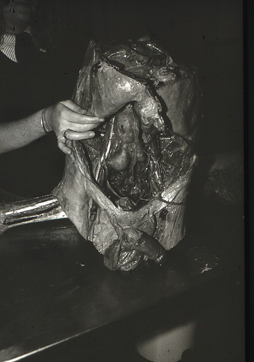
The novelist John Barth appropriates the biologist Ernst Haeckel's
statement "ontogeny recapitulates phylogeny," but substitutes the
word "cosmogony" for "phylogeny". Barth concludes: "the mystery of
the universe and the sphincter's riddle are identical because the
genesis of the individual and the genesis of the cosmos are aspects
of the same process".
The simple consideration of the nature of the sex act from the
insertion of the penis to ejaculation would seem to support this assumption.
The terminal event of coitus, the ejaculation of semen, may be considered
a urethral phenomenon, which has in common with the voiding of urine
not only its channel of excretion but the fact of being the ejection
of a fluid under great pressure. It is notable that during the frictional
process inhibitory influences, emanating from the sphincter, seem
to assert themselves, and are capable, if they predominate, of bringing
about a complete cessation of ejaculation. However, everything points
to the proposition that the urethral (i.e., ejaculatory) tendency
is at work from the beginning, throughout the entire frictional process,
and that in consequence a dialectical contradiction emerges between,
on the one hand, evacuation and expulsion, and on the other hand,
between inhibition and retention; in which, in the 'lonely hour' of
the 'last instance', the urethral element asserts itself as the 'structure
in dominance'. This dialectic manifests itself in the to-and-fro motion
of the frictional process, in which penetration corresponds to the
ejaculatory tendency, and withdrawal to a perpetually recurring inhibition.
In accordance with the laws of dialectical materialism (akin to the
transformation of water at a certain point of temperature into either
steam or ice), the accumulation of quantitative changes (the excitement
resulting from prolonged friction) leads to a qualitative 'leap':
upon exceeding a certain level, the increase of excitement consequent
upon continued friction, finally overcomes the (retentive) spasm of
the sphincter, resulting in ejaculation of the seminal material (spermata).
The term endoscopy encompasses a number of different medical procedures.
For example, gastroscopy visualises the upper digestive tract, sigmoidoscopy
visualises the lower digestive tract, and laparoscopy visualises the
organs which can be accessed via a puncture through the navel. Apart
from being used for the internal visualisation of the body for medical
diagnostic evaluation and therapeutic intervention, images obtained
by endoscope techniques are used to bring us face to face, so to speak,
with the immediacy of the body's interior.
Thus the invention of the endoscope is one of many medical instruments
whose genealogy can be traced to the dissecting gaze of the anatomist,
Andreas Vesalius. Casting aside all ideality of the body's formal
appeal, this mode of seeing incised right into the fabric of flesh
in order to disclose, by means of light, the minutest detail of its
vital function. This conception contrasts with the traditional view
of anatomy as a morbid practice carried out under the curtain of night
which life paradoxically threw over the body's inner workings. It
was only after death that it was acceptable for the portals of the
corpse to be opened up to the light of day. To quote the philosopher
Michel Foucault: "Nineteenth century medicine was haunted by that
absolute eye that cadaverizes life, and rediscovers in the corpse
the frail, broken nervure of life". Opening up the corpses, Foucault
maintains, gave medicine the opportunity to subject the entire human
body to the scientific Gaze. Thus Scientific Objectivity meets the
naked individual. From a teleological perspective, the endoscope triumphs
over the tradition of the morbid anatomist by rending the curtain
of night. The European Enlightenment thus arrives as sight, and it
is the history of the gaze transmuted into systems of surveillance
and control that constitutes the principal point of attack of <SPK>.
The history of European science is replete with descriptions of
the unveiling, stripping and laying bare of the female body as a metaphor
for the activities of the male scientist engaged in the activity of
discovering nature's hidden secrets. Freud described female psychology
in terms of the colonist and the conquistador, as "a 'dark continent'.............still
veiled in impenetrable obscurity". In the Eighteenth century, scientists
of the European Enlightenment were aided in their attempts at discovering
the secret inner workings of the human body through the extensive
use of "Anatomical Venuses". These 'Venuses' were finely detailed
life-like reproductions of the female body made from wax; and they
came complete with hair, jewellery and internal organs, passive and
with their insides open to the exploratory gaze of the anatomist.
For the pioneering gynaecologist Marion Sims, writing in the mid-Nineteenth
century, employing the newly invented speculum made him feel "like
an explorer in medicine who first views a new and important territory..............a
colonising and conquering hero". <SPK> turns its speculum back
upon the world once again.
The
Psychotic Imaginary
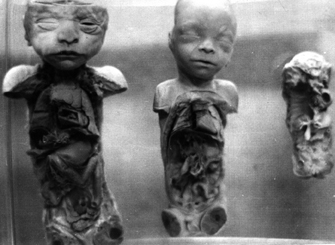
The philosopher Karl Marx exults in that colourful allure of the sublime
imagination latent in the "youthful and fantastic dream" of Hegelian
philosophy, and he aspired to bring reality into harmony with that
idealised image of a world that philosophy had hitherto realised only
in thought. In a spirit of optimism, Marx proclaims that the world
"has not yet become clear to itself. It will then turn out that the
world has long dreamt of that of which it had only to have a clear
idea to possess it really". Marx's autopsy upon what he describes
as the "putrefying corpse" of Hegel's philosophical system,
likewise applies to the psychoanalyst Sigmund Freud's interpretation
of the phantasmatical dreams dredged from the hidden depths and dark
recesses of his patients' unconscious - a realm he describes as a
"seething cauldron of excitations". The marriage of Marx's hermeneutics
and Freud's 'Dream-work' provides <SPK> with a theoretical concept
that triggers an area of research: the latent dream content is placed
in opposition to the prosaic, everyday world of conscious activity.
This promises a ludic permutation, an alternative model of accepted
social reality, amounting to the potential for a revolutionary metamorphosis
and the realisation of a 'surreality'-
a pataphysical transformation of society.
Thus Freud defines dreams as the symbolic fulfilment of desires
denied satisfaction in the real world, along with the inevitable conflict
that ensues between, on the one hand, the body's demands for a pleasurable
satisfaction of its desires and, on the other hand, a disagreeable
reality that obstructs the gratification of these desires. A conflict
ameliorated through the construction of an interior world of 'phantasy',
described by Freud as a kind of nature reserve where humanity's unfulfilled
desires are protected, providing the blueprints and building blocks
for the construction of a new reality to replace the old.
A process where accepted notions of what differentiates 'normalcy'
from 'psychosis' disappear in the common goal of transforming reality
in accordance with the wishful constructions preserved in phantasy.
This results in two different approaches: in practical action directed
towards the outside world designed to achieve the remoulding of objective
reality in favour of erotic desires previously denied (Freud's "alloplastic
adaptation"); or, conversely, in a 'psychotic' - philosophically idealist
- approach, concentrating upon passive, internal changes, amounting
to the construction in thought of an ideal reality as a substitute
for the partial or complete denial of the existence of the real external
world (Freud's "autoplastic adaptation"). <SPK>'s intense interest
in the deranged sensory awareness, visions, and artistic productions
of the clinically insane, amounts to an exploration the liminal space
where the psychotic imaginary intersects with 'normalcy' in the revolutionary
transformation of reality.
Body
Dysmorphology
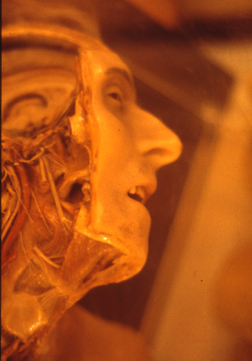
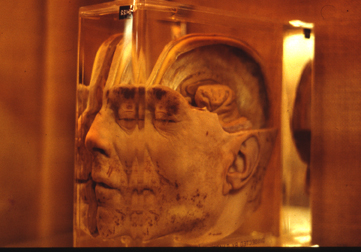
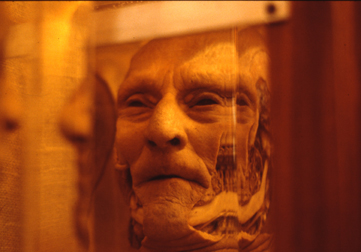
<SPK> is keenly interested in exploring the notion that the
human body is in a continual process of production and transformation.
There is a constant interchange between the subject and the world
in the ways in which the body's boundaries shrink or expand, incorporates
objects into itself, or expels impulses and substances emanating from
within. Relations between the body and its surrounding environment
are blurred and confused - the outside environment is not distinct
from the body but is an active internal component of its 'identity'.
The borders of the body are not fixed or confined to its anatomical
'container', the skin. The boundaries are extremely fluid and dynamic,
and there is an ongoing interchange between inside and outside.
The plasticity of our conceptions of the body and its boundaries
is indicated by what many social scientists are currently describing
as a pandemic what they call 'body dysmorphic disorder'. People suffering
this disorder feel that their bodies are somehow incomplete or imperfect.
The illness generally manifests itself in the form of the more common
eating disorders, such as bulimia or anorexia nervosa; but there are
also patients with an obsessive desire to acquire extra body parts,
or to have otherwise healthy limbs surgically removed because they
perceive them as somehow ugly, extraneous, or abject.
Dr Joseph Rosen, Associate Professor of Plastic and Reconstructive
Surgery at Dartmouth Hitchcock Medical Centre, New Hampshire, asserts
that our limbs are intimately connected to neural networks or maps
within our brains which possess the capacity to contract or expand.
When we have a limb amputated, it takes considerable time for our
neural map of that limb to contract or fade (hence the phantom limb
effect). Alternatively, if we acquire an extra body part, our neural
map expands accordingly. For Dr Rosen, this discovery opens up infinite
possibilities for the reconstruction of the human body.
Dr Rosen believes, with current surgical techniques with the capacity
to rearrange rib bones and stretch torso fat, in the near future it
will be possible to create wings for the human body. Although we would
lack the ability to fly, we would resemble angels, and our wings,
hanging flaps of boned tissue, would possess full sensation. Dr Rosen
is also currently developing methods of equipping the human body with
tails and enhanced hearing. In response to criticism from his peers
at a recent conference of plastic surgeons, Dr Rosen posed the question:
Why do we only value the average? Why are plastic
surgeons dedicated only to restoring our current notions
of the conventional, as opposed to letting people explore, if they want, the possibilities? Human wings will be here; mark my words. If I were to give you wings, you would develop, literally, a winged
brain. Our bodies change our brains, and our brains are infinitely mouldable.
The
Eroticism of Death
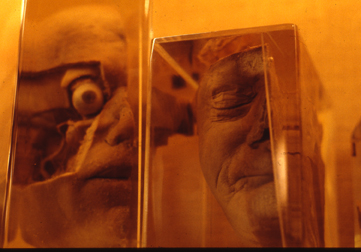
Through music and images, <SPK> traces an historical trajectory
of the human body's objectification. An exploration of what amounts
to a psychopathic dismemberment of the human body experienced as a
random jumble of fragmented parts; a solidified, un-individuated mass,
synonymous with the artist Antonin Artaud's 'body without organs'
and his Theatre of Cruelty: deformity and the material horror of annihilation
- the flash of the knife and the moment of truth. The image of the
body cut, dissected, ripped, eviscerated, tortured and abject; emptied
out and displayed; part human and part machine - visceral, fluid and
sticky with blood, semen, faeces and urine. The body monstrously there, but already so alien as to constitute
a horrific 'Other': a sticky mess of undifferentiated organs - a type
of interior slime. <SPK>'s objective is to envisage the emergence
of new anatomical structures: fluid-filled, corporeal machines, uncannily
exposed to a fascinated and sensationalized gaze, where the body,
sexuality, death and violence underwrite the wildest fetishes.
The praxis of <SPK> is centred on corporeality
and a philosophically consistent, 'base' materialism ('coporalia')
ending in revelation and annihilation, scandal and catastrophe. A
perverse cornucopia of chilling imagery, expressing a society immersed
in the throes of libidinous violence, the actualisation of Sadean
fantasy, genocide, and the wholesale transgression of traditional
taboos. <SPK> explores the fatal moment prophesied by the philosopher
Martin Heidegger's reflections on a technological logic culminating
in the Death Camps, and drifting into the suicidal nihilism and terminal
catastrophe of the present.
The fatal residues of history have completed the dismal task of
reification: the transformation of humanity into a 'thing'. The atomized
human individual exists as a bare commodity, an exchange value locked
into a system of production, with the human personality progressively
denuded of 'depth': a mere 'surface affect' manipulated by the increasingly
sophisticated images of a consumption industry intent on colonising
the human psyche, producing new and fragmented forms of commercialised
'personhood' ('subjectification'). This marks a form of control amounting
to a convergence of powerful systems of external, spectacular surveillance
with seemingly apolitical regimes of 'self'-surveillance,
producing a compliant complicity with the status quo. A
mass conformity inextricably combined with a psychologically regressive
passivity.
Through the vectors of instantaneous communication, our senses
are overloaded exponentially with an increasing mass of information
depicting a world on the brink of catastrophe. We are beset with an
information overload culminating in an all-pervasive paranoia concerning
the global realities of war, mass poverty, plague, genocide, terror,
torture, arbitrary imprisonment, fundamentalist economic and religious
fanaticisms, serial murder, and the rapid destruction of the ecosphere.

In response to the dominant ideologies of power and privilege responsible
for the present chaos, <SPK> resorts to the iconoclasm of the
hammer, combined with cultural electroconvulsive shock therapy. In
connection with our own empirical observations, we find the horrors
of the human condition embodied in the plastic creations and fragmented
experiences of marginalised artists deemed clinically insane: personalities
who turn inward in response to the experience of chaos and dehumanization
in Late Capitalist society. An outer environment experienced as an
alien, frozen world congealed into objective ('reified') historical
structures (social relationships), dominating and destroying our lives.
Critically opposed to this appalling state of affairs, <SPK>
insinuates itself into the ruptures, cracks and fissures of this frozen
world in a rearguard attempt to expose the hollowness and corruption
of its inward decay, to corrode the empty facades that support and
legitimise it from without. Our activities consist in the establishment
of correspondences between seemingly disconnected facts, combined
with the juxtaposition of disparate images and the elaboration of
electronic 'noise' (dissonance), culminating in <SPK>'s development
of a consummate technical skill designed to reflect the confused and
disfigured nature of contemporary reality. These skills are informed
by the shifting, multi-faceted and multi-perspectival techniques of
seminal writers such as Louis-Ferdinand Celine, and William S. Burroughs.
Artists who embrace a critical nihilism against the tired and sclerotic
orthodoxies of objective truth, countering the routinization of language
and life with the bitter-sweet taste of a the erotic, and the hallucinatory
intensities of colour, amidst the grimy numbness of human bodies instrumentalized,
brutalized and exhausted by the economic rationalist fundamentalism
of the transnational corporations of a globalized New World Order.
The music of <SPK> is not an alibi, a comfortable retreat, but
a descent to the subterranean depths of the political scene - a vast
crypt from which the underside of politics can be viewed upside-down
or turned inside-out.
The strength and relevance of <SPK>'s music lies precisely
in the emancipated dissonance that refuses resolution, harmony, consolation,
the quieting of tension in easy repose, or easy comfort. Instead,
we give expression in sound, text, images and performance to the disharmonies
of contemporary society - the 'nightmare'that is the world 'out there'.
The ultimate goal of our music is to form, within itself, within its
very structure, the force of those contradictions and the need to
resolve them in society. We will succeed the more precisely we express,
in the forms and language of our musical compositions and imagery,
the miseries of the status quo, emphatically calling, through the
ciphered language of suffering, for change.
<SPK>'s praxis experiments
with disruptive and interpolative techniques along with montage and
other devices of discontinuity. Accordingly we strive to exploit the
fissures in surface inter-relations, to discover premonitions of an
apocalyptic utopian promise in the interstices of our totalitarian
society. This includes a detailed exploration of decadence leading
to a nihilism composed of a random collection of musical notes; shocking
images; gobbledygook; fragments of nonsense; a mouth without an Ego,
drinking, babbling, pouring it out; confidence tricks in all shapes
and sizes; the jokes of a man who has lost his moorings; blind alleys
but with paths leading everywhere - with no aims but innumerable destinations;
synchronised with the attempt to found a scholastic system grounded
on chaos.
<SPK's dissection of contemporary culture relentlessly discloses
the worm in the bud. Accordingly we are interested in the visceral
and frequently violent nature of sexuality, particularly as it is
expressed in the complex sado-masochistic patterns of inversion and
identification, projection and introjection, submission and domination,
exhibitionism and voyeurism. All in all, that dynamic dance of opposites
constituting human social interaction.

Drawing upon the philosophical speculations of the Marquis de Sade,
the surrealist writer Georges Bataille writes of the fundamental link
"between death and sexual excitement", adding, "In essence, the domain
of eroticism is the domain of violence, of violation". Bataille's
celebration of sexual violence and the perverse rigorously avoids
any association of eroticism with what might be called purely spiritual
concepts of ideal beauty, love or romance. Instead, Bataille revels
in the links he painstakingly establishes between eroticism and the
more earthly concerns of ripeness and decay, the cycles of sexual
expenditure, discharge and release, and feelings of repugnance and
disgust.
For Bataille, "Eroticism springs from an alternation of fascination
and horror", a fascination expressed in the seductive nature of the
monstrous and the grotesque. The goal of course is the attainment
of unity through the symbolic fusion of two individuals in a sexual
embrace that collapses socially prescribed boundaries and constraints.
The participants experience a liberating destruction of the "isolation"
and "self-contained character" characteristic of their "normal" lives
as "discontinuous individuals". The result is an erotic union that
completely breaks down the distinction of 'self' and 'other' through
a process of the inside collapsing into the outside producing "a feeling
of profound continuity", where the individual, who would normally
regard themselves with the utmost importance and their sexuality as
a means, like any other, for their own satisfaction, become conscious
of themselves from a biological standpoint as only a brief episode
in a succession of generations, as merely a short-lived appendage
to a germ-plasm endowed with virtual immortality.
In speaking of the germ cells that "work against the death of the
living substance and succeed in winning for it what we can only regard
as potential immortality", Freud argues:
The instincts which watch over the destinies of these elementary organisms that survive the whole individual, which provide them with a safe shelter while they are defenceless against the stimuli of the external world, which bring about their meeting with other germ-cells, and so on - these constitute
the group of the sexual instincts. They operate against the purpose of the other instincts, which
leads, by reason of their function, to the final aim of life, the task of which is to lead organic life back into the inanimate state - death. It is as though the life of the organism moves with a vacillating rhythm. One group of instincts rushes forward so as to reach the final aim of life as swiftly as possible; but when a certain stage has been reached, the other group jerks back to a certain point to make a fresh start and so prolong the journey.
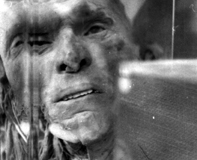
Freud describes the death drive as "the most universal endeavour
of all living substance - namely to return to the quiescence of the
inorganic world". Like a river winding its way back to the sea, life
is but a series of complicated detours" or "circuitous paths to death". Freud's
hypothesis of a death drive is illustrated by the "momentary extinction"
of orgasm, and a theory of origins derived from "the poet-philosopher"
Plato: "the hypothesis that living substance at the time of its coming
to life was torn apart into small particles, which have ever since
endeavoured to reunite through the sexual instincts".
For Freud this living substance is forever striving to regain its
lost unity, the plenitude of its being, through the achievement of
an increasingly complex and diversified "combination of the particles
into which living substance was originally dispersed". Freud marvels
at the almost insurmountable difficulties encountered by the first
unicellular organisms - "splintered fragments of living substance"
- in their first attempts at forming themselves into multi-cellular
entities, and the necessity "which compelled them to form a protective cortical layer
by an environment charged with dangerous stimuli". The colonies of
cells that make up multi-cellular organisms thus constitute a defence
mechanism against a hostile external environment.
Freud's equation of life and death, the animate and the inanimate,
Eros and Thanatos, represents a striving - intrinsic to all living
substance - to find its way to a final state of entopic dissolution
and restful oblivion, as a return to a lost unity. The notion of the
fundamentally regressive and conservative nature of the instincts
connects with Freud's hypothesis, according to which life originates
from a type of crystalline matrix, owing to the disruption of inorganic
matter by an ancient cosmic catastrophe. Freud's answer to the question
of life, its origins and direction, appears, to <SPK>, as an
endlessly circular affair, a ceaseless ebb and flow - "But here, I
think, the moment has come for breaking off".
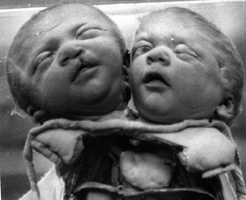
In an essay titled 'Mouth', Bataille establishes the difference
between animal and humans as fundamentally a difference in symmetry.
The mouth and anus of the animal, he suggests, forms a straight line
with the animal's mouth. In the verticality of human anatomy, however,
the mouth recedes and the eyes take on greater significance. It is
only in the moments of greatest pleasure and pain, Bataille asserts,
that the human body reverts to its most primitive form. In these extreme
states the body falls to the horizontal position, the head is thrust
back and the mouth, now open and protruding, issues a cry. In transposing
the animal form onto the human body in his essay "Ear", Bataille affirms
this collapse of the hierarchical status of the rational, knowing
subject.
"Story of the Eye", Bataille's fantasy of ocular violation, employs
the eye as a metaphor for the contradiction existing at the heart
of human existence; the contradiction between transgression and prohibition
as the axis around which desire is played out. The transgressive occupies
the liminal space between the asexual maternal and the sexual feminine,
incorporating fascination and terror, fear and desire, horror and
seduction. This amounts to a radical destabilisation of the limits
and boundaries of human subjectivity. According to Bataille:
It seems impossible to judge the eye using any word
other than seductive, since nothing is more attractive in the bodies of animals and men. But extreme seductiveness
is probably at the boundaryof horror.
In Freudian theory the eye is synonymous with the phallus so that
violence against the eye figures as a symbol for castration. Freud
writes:
A study of dreams, phantasies and myths has taught us that anxiety about one's eyes, the fear of going blind, is often enough a substitute for the dread of being
castrated. The self-blinding of the mythical criminal Oedipus was simply a mitigated form of the punishment of castration.
The violence contained in Bataille's "Story of the Eye" is linked
to the image of the vagina (the 'vagina dentata')
as a terrifying consuming organ, one that voraciously consumes a vast
array of objects: an egg, an eye, a bull's testicle and the erect
penis of a dying man. Coitus and explicit acts of sexual fetishism
are politically deployed against the profane world of capital accumulation
and commodity fetishism, in favour of an excessive, unproductive expenditure
associated with religious ecstasy and the realm of the sacred.
The enucleated eye - everywhere in Bataille's oeuvre a symbol of
the hierarchical transcendence of philosophical idealism - is returned
to the body's two lowest orifices - the anus and the vagina. Against
the eye as a symbol of disembodied reason, Bataille possessed a fondness
for the labyrinth as an alternative to the pyramid, that architectural
symbol of solidity and substance, homologous to the optical cone and
the tumescence of hierarchical social structures.
